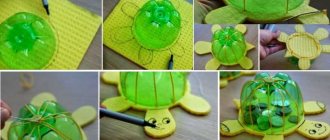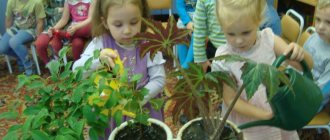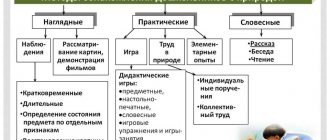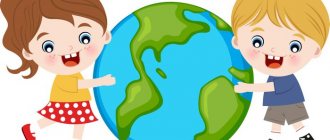Innovative technologies for environmental education of preschool children
Nature is a great teacher! Environmental education is very closely related to moral education - this is the education of humanity, kindness, mercy, and a responsible attitude towards nature and the people who live nearby. Our task is to teach the child to treat every living organism as a valuable, unique entity that has the right to life. The best result can be achieved if you begin to form the foundations of environmental culture in preschool age.
To make every day of children’s stay in kindergarten interesting and eventful, we try to implement the tasks of environmental education through an integrated approach to teaching and use innovative technologies in our work.
A way for children to understand the world around them is through play. Role-playing is a method in which children act out a life situation. Children model their own behavior and build relationships. In role-playing games, the child’s social competencies are actively formed. We give role-playing games an ecological character: “Journey to the Forest”, “Journey to Neptune”, “Journey to the Moon”, “Zoological Store”, “Vitamin Lunch”, etc.
In our work we also use puzzle games, experiment games, research games, meditation games
(“I am Rain”, “I am Sun”, “I am Wind”, “Sun and Cloud” and others) give new impressions about the life and work of people, about the state of nature and its changes; awaken interest in nature and develop a value-based attitude towards it. Form motives and practical skills for environmentally appropriate activities; provide opportunities for independence, initiative, cooperation, responsibility and the ability to make good decisions. In these games, children use their life experience and reflect what interests, excites, and pleases them.
An interesting game technique in working with children is receiving letters of complaints from residents of a living area, residents of a forest, garden, or vegetable garden. When children receive such a letter, they think about its contents, discuss various environmental situations, decide how they can help this or that living creature, how they need to preserve and protect the nature of their land and the entire planet.
To develop in children the ability to analyze various problems and find solutions, as well as the ability to work with information, we use case technologies in our work. A technology case is an analysis of a situation or a specific case, a business game.
Case - technologies develop communicative competencies in those educational areas where there is no clear answer to the question posed, but there are several answers, and you need to find the right answer by arguing your reasons. For example, the case illustration “Does a child behave correctly in nature?”
The “Good-Bad” discussion method improves children’s knowledge about the phenomena of living and inanimate nature, animals and plants. Children are offered different situations, and they make conclusions, for example: “Why did the leaf turn yellow?”, “A lot of snow in winter - is it good or bad?”, “If all the birds on earth disappear - is it good or bad?”, “They go every day.” Is rain good or bad?”, etc. The purpose of such a case is to jointly analyze the situation, find a way out, the correct version. Business game “Who is after whom?” Shows children that in nature everything is interconnected.
Business game “What will happen if ...?” helps to learn what needs to be done in order to protect, preserve and enhance nature, develops the ability to draw conclusions and conclusions. For example: “ What happens if you don’t put out a fire in the forest? "
Business game “Take care of nature.” Invite children to look at pictures depicting plants, birds, animals, humans, the sun, water, etc. One of the pictures is removed, and the children must tell what will happen to the remaining living objects if there is no hidden object on Earth. For example: we remove a bird - what will happen to the rest of the animals, to humans, to plants, etc.
Information and computer technologies are widely used to improve and update the forms and methods of working with children.
A child, with his visual-imaginative thinking, understands only what can be simultaneously viewed, heard, acted upon, or evaluated the action of an object. This is why it is so important when teaching preschoolers to access the channels of information available to them.
Introducing children to nature, we use a variety of materials: didactic pictures, reproductions of artistic paintings, photographs, videos, sound recordings, in which children become active objects of pedagogical influence.
We use the following types of illustrative and visual materials on electronic media, such as:
1. Sound materials are recordings of the voices of birds, mammals, the noise of the forest, surf, rain, wind, etc.
2. Screen materials are slides dedicated to a specific topic.
3. Multimedia presentations are educational screensavers with beautiful, bright pictures that help teach children about the world around them. The presentation combines dynamics, sound, and colorful images, which significantly improves the perception of information.
3. multimedia environmental games both in the content of classes to get acquainted with the outside world, and in free activities: travel games, riddle games, didactic games, quizzes, physical exercises, finger games.
4. Media classes, which I conduct in a group room using a laptop or in a music room equipped with a computer, projector and screen.
An effective method of expanding knowledge on ecology is the use of pearls of folk wisdom - fairy tales, legends, sayings, riddles on environmental topics . The goal is to enrich the mind and excite the soul, and not so much to provide ready-made answers to the questions posed, but to develop the child’s ability to think independently, using his experience and previous observations: “If there is a lot of forest, don’t destroy it, if there is a little forest, take care of it, if there is no forest, plant it.” etc.
One of the forms of non-traditional environmental education for preschool children is environmental theater , which promotes the development of a sense of collectivism, responsibility, forms the experience of moral behavior, and influences the spiritual and moral development of the individual. Children reveal environmental problems through costumed theatrical performances including songs, dances, and propaganda ditties that promote environmental protection. Parents of students are involved in the organization of environmental theater. Ecological theater opens up wide possibilities for creative search, the result of which is new knowledge about our common home, about our neighbors on the planet, about the interdependence of man and nature. Ecological theater classes provide an opportunity not only to study and understand the world around us, but also to live in harmony with it.
Conducting competitions, quizzes, brain rings, entertainment and environmental celebrations, such as “What? Where? When?"; "Nature Experts"; “We are friends of nature”; "Earth Day"; "Birthday of the forest"; "Gold autumn"; “Titmouse Day” helps children feel like they are part of nature. Children are happy to perform in front of their friends, as well as in front of their parents, who are not only frequent guests, but also participants at our holidays.
Another interesting form of working with children is promotions.
In our preschool, environmental events take place throughout the school year. During the events, preschoolers receive natural history knowledge, develop environmental culture skills, and an active life position. The promotions serve as good environmental propaganda among the parent community. Children see the attitude of their parents, the organization of the event and participate in it themselves. Each action is held under its own motto and has visual propaganda (leaflets, posters, memos).
Types of actions: “Let's protect spruce and pine” ; “Feed the birds in winter” ; "Snow blanket for trees"; "Take care of the primroses" ; “Let's decorate the planet with flowers”; “Clean yard - clean planet”; “Protect the forest and its inhabitants from fire!”
As an innovative form of environmental education, we use the ecological trail .
An ecological path allows you to more productively use regular walks with children for environmental activities and at the same time for children’s health in the fresh air. The same objects can be visited many times, especially in different seasons of the year. On the path we conduct observations, games, theatrical activities, and excursions. It is very important to remember the integrated approach: on the path, the children and I observe, examine, discuss, analyze, etc., then the children express their impressions of what they saw, their acquired knowledge about nature, in different types of activities: visual, musical, which helps to consolidate this knowledge in the child’s memory.
Preschool children, with their desire to understand the world around them, present great opportunities for developing a moral position in relation to their native land. the organization of the “I want to know everything!” circle to be innovative in this work. on experimental activities, where the child is given complete freedom to demonstrate cognitive, emotional, social and motor activity in the process of experimentation.
Let's decide together
Can't enroll your child in kindergarten? Would you like to tell us about the teachers? Do you know how to improve your diet and exercise?
Municipal budgetary preschool educational institution, kindergarten of general developmental type No. 11 “Firefly” of the Municipal Entity Timashevsky District (MBDOU d/s No. 11) was opened in 1966.
If there is an island of love, joy, and happiness on Earth, then this is MBDOU d/s No. 11 “Firefly”. Our preschool educational institution is a living organism that breathes, feels, and rejoices. We try to penetrate every child's heart, instill in it joy, love, kindness. Preschool educational institutions are parents. They are the main assistants in our work and we are very grateful to them for this. Preschool educational institutions are employees. The most hardworking, creative people who can do everything, who care about everything with their souls, who love children. A preschool is a big family. And like any friendly family, we have our own traditions. If you want your baby to feel comfortable, to develop in accordance with his capabilities and abilities, come to us at the Firefly kindergarten.
The preschool educational institution operates in accordance with the Federal Law “On Education in the Russian Federation”. A license was issued for the right to carry out educational activities under educational programs dated March 12, 2013 No. 05353. The preschool educational institution has a license to carry out medical activities dated December 5, 2012 No. LO-23-01-005240.
The preschool educational institution ensures a high level of development of preschool children in accordance with their age and individual characteristics. Contributes to the preservation of physical and mental health, intellectual, artistic and aesthetic, social and moral development, emotional comfort of the child and his socialization.
The preschool educational institution works according to the “Basic general educational program of preschool education.”
In addition to the basic forms, teachers use new methods, technologies, and partial programs in their work:
- “Education of ecological culture among preschool children” (S.N. Nikolaeva)
“Fundamentals of the safety of preschool children” (R.B. Sterkina,)
MAIN TASKS OF EDUCATION AND TRAINING IN KINDERGARTEN:
- protecting the lives and strengthening the physical and mental health of children;
- ensuring the intellectual, personal and physical development of the child;
- introducing children to universal human values;
- interaction with the family to ensure the full development of the child.
PRIORITY DIRECTIONS:
- protecting the lives and strengthening the physical and mental health of children
- artistic and aesthetic education of children;
- interaction with the family to ensure the full development of the child.
The teachers will make sure that your child becomes independent, sociable, active, inquisitive, learns to think, develops his creative abilities, joins the world of art, and learns to create his own artistic creations; musical director L.E. Chernyavskaya will reveal the talents of your baby and he will become a real little artist; work on moral and patriotic education is carried out, skills and abilities in visual arts are improved, taking into account the age characteristics of children. Work is underway on environmental education in all groups, there is an environmental classroom “Ladybug” in which senior students conduct experiments and experiments, based on the developments of the programs “Young Ecologist” by S.N. Nikolaeva and “Our Home is Nature” by N.A. Ryzhova. Children develop a conscious attitude towards natural phenomena, towards themselves and their health. At the preschool educational institution a complex of health-improving and educational activities is carried out, the basis of which is motor activity, these are: physical education classes; physical education and health work during the day (morning exercises, physical education minutes, outdoor games and physical exercises, hardening activities, gymnastics after sleep, “health paths”); active recreation (physical education and holidays, health days, vacations); health services: phytoncidotherapy.
We provide additional development of children’s individual abilities in the “Bell” - vocal circle.
Pedagogical principles of the team:
We raise friendly, cheerful and resourceful people. We warm you with affection, warmth, care. We develop healthy, strong, dexterous people. We sow reasonable, good, eternal things.
Every child in our garden is a clear star. And this star shines brighter because she knows that she is loved and valued, knows that she will not be abandoned, but will be helped to achieve perfection.
Dear mothers and fathers, grandparents!
We are glad to welcome you to our website!
Why did we open our website on the Internet?
In order to tell more about the preschool institution, which has become a second home for us, about the kind and creative employees who give a piece of their soul and warmth to our dear students, as well as about the children themselves, whose upbringing and education we consider the most important activity. We strive to ensure that the preschool educational institution is for everyone who visits it a home in which comfort, coziness and kindness reign, where music and sonorous children's laughter are heard, a home to which they come with joy.
On this website you can get all the necessary information about the life of our kindergarten.
You can find out information about how we live. We will talk about past events and significant dates. You can look at our photo album and learn from us some experience in conducting classes and consultations.
- In the “Guest Book” section you can contact us and leave wishes and comments on the work of the preschool educational institution in general, as well as get acquainted with the opinions of other parents;
- The “Kindergarten Events” and “News” sections contain notes of classes and events conducted by our teachers;
- The “Garden Tour” section contains photographic materials of the territory of the preschool educational institution, interesting events held in the preschool educational institution, etc.;
- In the “Information for Parents” section you will find a lot of interesting things: games, poems, songs, riddles and much more;
- In the “Recommendations from Experts” section you can find consultations for educators and parents.
We hope that our site will be useful to both parents of pupils of our preschool educational institution and many others. If you have questions regarding MBDOU d/s 11, you can ask them to our email address.
We are waiting for you at:
Krasnodar region, Timashevsk microdistrict. Sugar factory 8.
tel./fax: 8 (86130) 5-35-77
Sincerely, Head of MBDOU d/s No. 11 Avramenko Tatyana Andreevna
MAGAZINE Preschooler.RF
Innovative approaches in environmental education of preschool children.Teachers: Martynenko S.F., Glushchenko A.V.
Nature is a great teacher! Environmental education is very closely related to moral education - this is the education of humanity, kindness, mercy, and a responsible attitude towards nature and the people who live nearby. During preschool childhood, the child undergoes intensive social development, which is carried out through his interaction with others, peers and adults. The period of formation of the foundations of a future personality is preschool age.
Our task is to teach the child to treat every living organism as a valuable, unique entity that has the right to life. The best result can be achieved if you begin to form the foundations of environmental culture in preschool age
The problem of the relationship between man and nature is not new; it has always existed. But now, at the present time, the environmental problem of interaction between man and nature, as well as the interaction of human society on the environment, has become very acute and has assumed enormous proportions.
At the present stage, issues of traditional interaction between nature and man have grown into a global environmental problem. If people do not learn to take care of nature in the near future, they will destroy themselves. And in order to prevent this from happening, it is necessary to cultivate an environmental culture and responsibility. And it is necessary to begin environmental education from preschool age, since it is at the stage of preschool childhood that the child receives emotional impressions of nature, accumulates ideas about different forms of life, that is, the fundamental principles of ecological thinking and consciousness are formed in him, and the initial elements of ecological culture are laid.
Innovative technologies have received their new development in environmental education, since the nature of environmental knowledge determines not only various forms of border integration of related subjects, but also the integration of various areas of education and training of preschool children.
Environmental education of preschool children can be carried out in different educational areas. Thus, the content of the educational field “Socio-communicative development” is aimed at mastering the norms and values accepted in society; development of emotional responsiveness, empathy, including in relation to natural objects. The content of the educational field “Cognition” is aimed at the formation of primary ideas about the objects of the surrounding world, their properties and relationships (color, shape, size, causes and effects, etc.). The content of the educational field “Speech Development” implies familiarity with children's literature, in particular natural history. The educational field “Artistic and Aesthetic Development” implies the formation of the foundations of value-semantic perception and understanding of the world around us. The educational field “Physical Development” is aimed at developing the values of a healthy lifestyle in children.
New types and forms of environmental education for preschoolers - didactic environmental games. Game is one of the types of human activity that is the leader in childhood. The value of the game cannot be limited to just entertainment opportunities. A didactic game is an active form of learning in which two principles operate simultaneously: educational and entertaining.
The didactic game is designed to soften the transition from one activity to another, to make the process of acquiring knowledge and ideas about the world easier. One of the forms of environmental education and upbringing in preschool educational institutions is environmental actions - this is a set of events and actions that helps children better understand a certain environmental problem, show their civic position, and express their attitude towards something.
Such events help consolidate knowledge about natural phenomena, teach children to independently plan their activities, and develop independence and responsibility in children.
Using new technologies in an interesting, entertaining way, it helps children see all the beauty of nature, reveal all its secrets and laws, and instills in children kindness and a responsible attitude towards the world around them and the people who live nearby.
Literature:
- Anokhin E.V., Bondarenko T.M., Sukhanova A.S., Bondarenko T.M. Environmental activities with children 6–7 years old. - Voronezh: Lakotsenin, 2007.
- Kondratyeva T.N., Kurochkina S.N. Environmental education of children of senior preschool age in the process of environmental actions // Problems of the formation of environmental thinking in modern society, materials of the International Scientific and Practical Internet Conference. — 2014.
- Pavlova L. Yu. Didactic games as a means of ecological and aesthetic education of children 5–7 years old: Dis. Ph.D. ped. Sci. - M., 2002.
| Next > |



